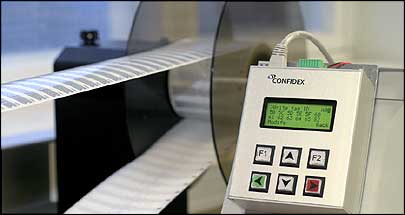Finnish company Confidex has developed a new tag tester specifically designed to read and encode RFID inlays during the process of manufacturing inlays or converting them into labels.
“Manufacturers are trying to produce inlays and labels, but are using commercial readers not designed for near-field or high-speed applications,” says Timo Lindstrom, partner and CEO at Confidex. By enabling higher-speed tag interrogation during manufacturing and converting, Confidex believes its new tag tester, the MR01, will help improve both the volume and quality of the RFID labels and tags.
“Because manufacturers can accurately follow the overall process flow, they can find out critical process steps and adjust them accordingly to increase inlay yield, and end users will get products where performance variations are smaller,” says Lari Kytölä, also a partner at Confidex.
Confidex’s new tag tester has a read-testing speed of up to 200,000 Class 1 Generation 2 inlays per hour and a write-testing speed of up to 18,000 inlays per hour. According to Confidex, this is around five times faster than existing testing systems.
The device has a focused read range of just a few millimeters, ensuring that each inlay is read without interference from reading other inlays as close as 20 millimeters away. The read range is limited with adjustable reader power and a specially designed near-field coupling antenna that creates a controlled and localized RF field distribution. This eliminates the need for mechanical shielding between adjacent tags.
“The MR01 is the first UHF system developed for high-speed moving inlays and inline quality control,” Kytölä claims. It consists of a controller unit and either one or two antenna units. By positioning two antennas next to each other, the MR01 can be used to test two inlays moving side-by-side through the production line. A pair of antennas can also be placed in positions both before and after a lamination process or other production step, to test to ensure no damage is taking place during the process. The tester also has a built-in display screen that shows the quantity of tags read, as well as the number of functioning and nonfunctioning tags.
The device can be installed on existing tag-handling machinery, with or without a host PC. If connected to a PC, it can also be used to collect data for statistical process control, but the focus of the device is high-speed reads. By removing reliance on a PC, the MR01 operates more quickly and is simpler to deploy, Confidex explains.
“The main function of the MR01 is RFID testing—to determine if the [tag] product functions or not—rather than collecting information,” says Kytölä.
The reader controller unit can read not only inlays complying with EPCglobal‘s Class 1 Gen 2 standard, but also those complying with ISO 18000-6b and, after a firmware upgrade, EPC Class 1 Gen 1. The unit is currently available for UHF tags in both the European and North American RFID spectra, with a version for HF tags scheduled for launch in April.


